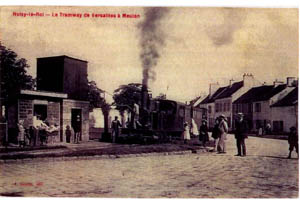
T.V.M. was born on May 13th 1896. It had a narrow
track width with steam engines and thus its speed was limited to
“It was intended to create fast and economical
connections between people who did not have access to practical transportation
systems, to promote trade or local products, to improve market supplying and,
at last, increase residential, vacation type housing”. The first part, between
Versailles and Noisy le Roi was opened on April 8th 1899. Originally,
MM Perrichon and Paul Galloti were given rights to operate this line, but
it was soon transferred to Société Française du T.V.M., and in October 8th,
the second part between Noisy le Roi and Maule was also opened.
The first train left Versailles at 6h 45, reached
Bailly at 7h 10, Noisy at 7h 17 and
arrived in Maule at 8 h 18 for a trip of
Stops were indicated by tiny buildings made of
bricks and mortar on millstone basements. The Feucherolles stop still exists
and can be seen on entering the village.
Noisy le Roi stop (facing the present post-office)
was equipped to supply water to the engines, and a branch connected T.V.M.
to the line of “Big Belt” where heavy goods for local industry were transferred
(bricks factory in Feucherolles, sugar plant in Chavenay, factory in Maule).
As early as summer 1899, inhabitants of Bailly
and Noisy le Roi complained about noise, excess speed and bad smelling heavy
smoke of the engine, a
Pinguely 020.
Track width was soon increased from the original
1m to 1,4m, but it did not improve the financial status of the company which,
with permanent deficit, is frequently resold.
Traffic is stopped from May 1st 1916 to August 15th 1920.
In 1924, steam engines are replaced by gasoline
railcars, but it is not enough to compete against the bus system. Moreover,
to improve the financial yield, T.V.M. carries crushed refuses from Versailles
to Les Mureaux, where they are spread as fertilizers. Carry such goods will
give to the T.V.M. the nickname of “mud train”. In 1928, le Mayor of St Nom
la Bretêche had purchased some land, just to allow these mud wagons to stand there in order to limit the inconveniences of smell.
Competition between train and trucks increased
steadily. Around 1930, the Moreux Company in La Tuilerie used T.V.M. to bring
the coal for their greenhouses, but soon trucks replaced train.
Apparently everything was against T.V.M. : good
roads, difficulty to run cars and railcars on the same ways, unfavourable
image of “mud train”, lead to a closure
in December 17th, 1938. War brought some relief, but traffic was completely
stopped in March 1944 and the track was declassified in July 1949 and dismantled.
_________________________